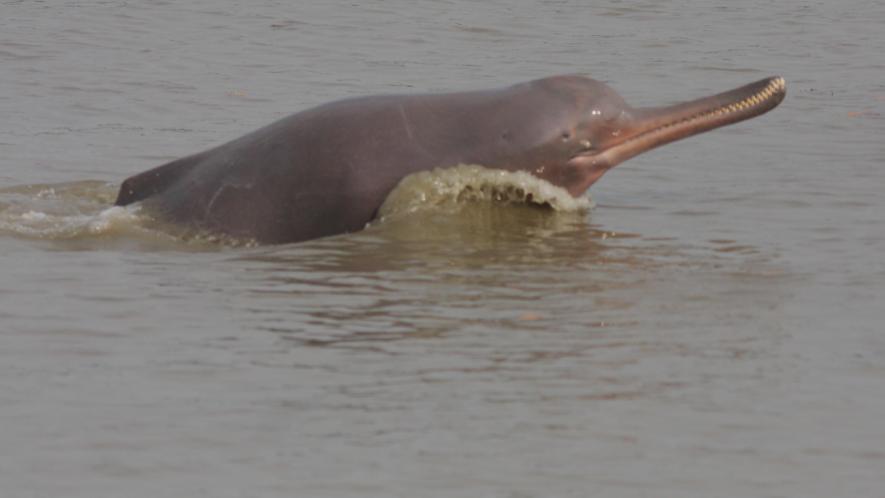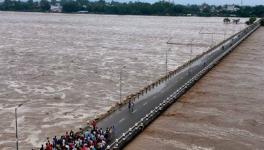'Dolphin Man' R K Sinha Questions Tagging Endangered Gangetic River Dolphins With a GPS Tracker

Image Courtesy: Wikimedia Commons
Patna: India’s reputed expert on the endangered Gangetic river dolphin R K Sinha has expressed his doubts over the feasibility of tagging endangered Gangetic river dolphins with a GPS tracker to monitor their movement and study their behaviour for conservation.
Sinha has raised a question on the claim of the Union Minister of State for Environment Ashwini Choubey, who on Tuesday during an online programme on Dolphin Day said that it was decided to tag dolphins with a GPS tracker to monitor movement for conservation.
Sinha, known as India’s 'Dolphin Man' and is also a member of the steering committee for implementation of the Project Dolphin, told NewsClick on Wednesday that it is a difficult task to tag dolphins with a GPS tracker or a chip or even an electronic device.”Till now such experiment has not succeeded anywhere because dolphins spent most of their time under the water in river and come out for few seconds to take a breath. It is not possible to charge the battery of a chip or an electronic device.” He said.
Unlike other wild animals, including tiger, elephant or endangered birds, Sinha said dolphins are totally different as they hardly spent a minute on the surface outside the water.”I have no knowledge of any such electronic device available for tagging dolphins without charging it. The chip or electronic device will stop working if the battery is not charged and there is no known facility for charging the battery”.
Sinha said he had known Choubey since college days, and he will talk to him regarding the difficulty to tag dolphins with a GPS tracker, as he reportedly stated.
Choubey, in his online address to researchers, environmental activists and officials in Bhagalpur to mark Dolphin Day on October 5, said that the central government has initiated project Dolphin to increase their population and improve conservation. The government will spend Rs 1500 Crore on it. ”Dolphins will be tagged with GPS tracker to monitor them”.
Choubey further said the much-awaited National Dolphin Research Centre (NDRC) is coming up in Patna. The NDRC for the conservation of dolphins is being constructed on the 4,400 square metre plot of land on the premises of Patna University, near the banks of the Ganga.
However, Sunil Choudhary, director of Vikramshila Biodiversity Research and Education Centre of Tilka Manjhi Bhagalpur University, has a different view on tagging dolphins with GPS tracker.”Choubey has informed us during his address that dolphins will be tagged with GPS tracker. It will certainly help scientists and conservationists to study their less known behaviour and movement. GPS tagging will help to monitor dolphins migration, feeding and travelling behaviour.This is a positive step for the conservation".
Choudhary said very little was known about how long dolphins moved from one place to another.”It will help research on dolphins that will help in their conservation”.According to Choudhary,Wildlife Conservation Trust has recently sent a proposal to the Bihar government to tag dolphins with GPS tracker.
Bihar is home to around half of the estimated 3,000 Gangetic dolphins in the country, as per the recent survey of the dolphins.
Sinha, said that dolphins’ presence is a sign of a healthy river ecosystem. “Dolphins prefer water that is at least five feet to eight feet deep. They are usually found in turbulent waters, where there are enough fish for them to feed on”.
Gangetic dolphins live in a zone with little or no current, which helps them save energy. If they sense danger, they can dive into deep waters. The dolphins swim from the no-current zone to the edges to hunt for fish and return, he added.
Demand for water from the river has been increasing with the rise in temperature. "We need more water, but the water level is declining in the river, putting more pressure on the dolphins to manage their life cycle," R.K. Sinha said.
Experts agree that Gangetic dolphins' habitat faces a serious threat from climate change. They pointed out that increasing pollution due to large-scale discharge of industrial and municipal waste, siltation, and mechanised boats pose the biggest danger to these freshwater dolphins.
The Gangetic river dolphin is India's national aquatic animal but frequently falls prey to poachers. Their carcasses are found regularly on river banks.
Gangetic river dolphins fall under Schedule I of the Indian Wildlife (Protection) Act and have been declared an endangered species by the International Union for Conservation of Nature (IUCN).
The Gangetic river dolphin is one of the four freshwater dolphin species in the world. The other three are found in the Yangtze River, China, the Indus river in Pakistan and the Amazon river in South America.
The Gangetic river dolphin – found in India, Bangladesh and Nepal – is blind and finds its way and prey in the river waters through echoes. These dolphins live by echolocation, and sound is everything to them. They navigate, feed, escape danger, find mates, breed, and nurse babies by echolocation.
Get the latest reports & analysis with people's perspective on Protests, movements & deep analytical videos, discussions of the current affairs in your Telegram app. Subscribe to NewsClick's Telegram channel & get Real-Time updates on stories, as they get published on our website.


















